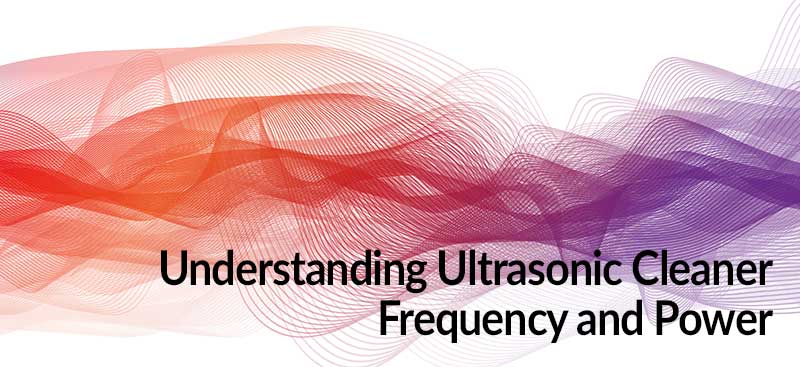
Ultrasonic Cleaner Frequency and Power
Selecting an ultrasonic cleaner for any cleaning and sample preparation operation requires careful consideration of many factors before making a purchasing decision. We offer useful guidelines in our post How to Pick the Best Ultrasonic Cleaner. This post focuses on two points in particular, frequency and power. Ultrasonic frequency is relatively easy to understand; understanding power is a bit more complicated. So let’s begin.
How to Specify Ultrasonic Frequency
Frequency is measured in thousands of cycles per second (kilohertz or kHz).
These frequencies are generated by transducers most commonly affixed to the bottom of the cleaning tank. Some ultrasonic units have transducers bonded to tank sides; others may have immersible transducers.
Wherever they are placed ultrasonic transducers are excited by the unit’s ultrasonic generator to produce millions of microscopic vacuum bubbles in the solution that implode on contact with parts being cleaned.
The implosions, called cavitation, remove contamination faster and more thoroughly than mechanical scrubbing using wash tanks or aerosol sprays.
(Note that this process is also used for fast, safe sample preparation in the lab.)
Ultrasonic frequency also determines cavitation bubble size.
Low frequencies such as 25 kHz produce relatively large bubbles that implode more violently than those created at higher frequencies that produce comparatively gentle cleaning action. Visually the size is virtually impossible to distinguish. For example a 25 kHz bubble has about 3 times the approximately 40 micron radius of 80 kHz.
Widely used Ultrasonic Frequencies and Applications
Here are some widely used ultrasonic frequencies and applications for Elmasonic units available from Tovatech:
| 25 kHz | Remove coarse, tenacious adhesive contaminants; pre-cleaning robust surfaces |
| 35 kHz and 37 kHz | Standard ultrasonic frequency for common cleaning jobs |
| 40 kHz | Ultrasonic cleaning jobs in the lab and in the sanitary sector |
| 45 kHz | For fine cleaning and for sensitive surfaces such as light metal alloys |
| 130 kHz | For micro-electronics, precision optics and similar highly sensitive surfaces |
So, what does this mean?
If you are removing gross contaminants from robust parts such as fabricated or cast metals specify a lower frequency ultrasonic cleaner.
If you are cleaning delicate items such as printed circuit boards, a higher frequency is recommended.
Popular benchtop ultrasonic cleaners for simple ultrasonic cleaning jobs are the 37 kHz Elmasonic E+ series in 9 tank sizes from .25 to 7.5 gallons. Models with additional useful features are exemplified by the 37 kHz Elmasonic Select line in 11 tank sizes.
Softer metals, plastics, and products with polished surfaces should be cleaned at higher ultrasonic frequencies. The smaller bubbles are less likely to cause surface damage. They are also better able to penetrate tight areas such as seams, crevices and blind holes.
If you are cleaning a variety of products consider a dual-frequency ultrasonic cleaner. An example is the Elmasonic P series that operates at 37 or 80 kHz.
The Role of Ultrasonic Power
Power has several definitions when discussing ultrasonic cleaning and is described in different ways by equipment manufacturers. In terms of cleaning power it is calculated as the power delivered to the transducers and expressed as watts per gallon (or liter) of cleaning solution. Most cleaners operate at 50 to 100 watts per gallon.
As power increases so do the number of bubbles, so increased power yields faster cleaning action but only up to a point. Beyond that you are not only wasting energy you also risk damaging parts being cleaned.
Total Power
Another definition is total power or the amount needed to drive everything in the unit including generators and heaters (if supplied). It should not be confused with power.
Peak Power
Peak power is defined as the ultrasonic power generated at the summit (or peak) of the vibration amplitude. In many cases the peak power equals 2X the average power.
But in some models peak performance may be 4X or 8X the average power depending on the wave shape.
You don’t need to understand the physics but you do need to understand that while it makes sense to compare the average power of two different units of the same size, it’s not meaningful to compare peak power of one unit to average power of a different unit. You would be comparing apples with oranges.
Variable power is offered on certain units such as the P series mentioned above. Another useful feature on the Elmasonic P series ultrasonic cleaners is a pulse mode that provides bursts of power to remove tenacious contaminants.
Still Have Questions About Frequency and Power?
This post does not answer all questions on frequency and power but should give you an idea of the importance of these features when purchasing an ultrasonic cleaner.
Call or chat with the ultrasonic professionals at Tovatech for guidance through the process and to recommend the correct equipment for your requirements.
